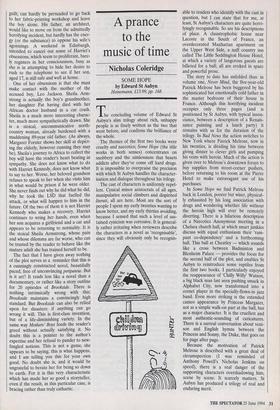A prance to the music of time
Nicholas Coleridge
SOME HOPE by Edward St Aubyn Heinemann, £13.99, pp. 168 he concluding volume of Edward St Aubyn's slim trilogy about rich, unhappy people is as finely written as the two that went before, and confirms the brilliance of the whole.
The themes of the first two books were cruelty and narcotics; Some Hope (the title works in both senses) concentrates on snobbery and the aimlessness that besets addicts after they've come off hard drugs. It is impossible to overpraise the precision with which St Aubyn handles the character- isation and dialogue throughout his trilogy.
The cast of characters is uniformly repel- lent. Cynical minor aristocrats of all ages, manipulative social climbers and dispirited literati, all are here. Most are the sort of people I spent my early twenties wanting to know better, and my early thirties avoiding, because I sensed that such a level of sus- tained cynicism was corrosive. It is general- ly rather irritating when reviewers describe the characters in a novel as 'recognisable', since they will obviously only be recognis- able to readers who identify with the cast in question, but I can state that for me, at least, St Aubyn's characters are quite horri- fyingly recognisable. So are his descriptions of place. A claustrophobic house near Lacoste in the South of France, an overdecorated Manhattan apartment on the Upper West Side, a naff country inn called The Little Soddington House Hotel, at which a variety of langorous guests are billeted for a ball; all are evoked in spare and powerful prose.
The story to date has unfolded thus: in volume one, Never Mind, the five-year-old Patrick Melrose has been buggered by his sophisticated but emotionally cold father in the master bedroom of their house in France. Although this horrifying incident occupies only three pages (and is positioned by St Aubyn, with typical insou- ciance, between a description of a Renais- sance painting and a lunch party) it remains with us for the duration of the trilogy. In Bad News the action switches to New York where Patrick Melrose, now in his twenties, is dividing his time between giving dinner to clever girls and pumping his veins with heroin. Much of the action is given over to Melrose's downtown forays to buy supplies from street-corner pushers, before returning to his room at the Pierre Hotel to make extravagant use of his purchases.
In Some Hope we find Patrick Melrose back in London, poorer but wiser, physical- ly exhausted by his long association with drugs and wondering whether life without the heroin high will ever be remotely diverting. There is a hilarious description of a Narcotics Anonymous meeting in a Chelsea church hall, at which smart junkies discuss with equal enthusiasm their 'ram- pant co-dependency' and a forthcoming ball. This ball at Cheatley — which sounds like a cross between Badminton and Blenheim Palace — provides the focus for the second half of the plot, and enables St Aubyn to reintroduce some reptiles from the first two books. I particularly enjoyed the reappearance of 'Chilly Willy' Watson, a big black man last seen pushing smack in Alphabet City, now transformed into a cornet player in the specially-flown-in jazz band. Even more striking is the extended cameo appearance by Princess Margaret, not as a simple walk-on part at the ball, but as a major character. It is the cruellest and most authentic-sounding of caricatures. There is a surreal conversation about veni- son and English hymns between the Princess and Sonny, the Duke, that goes on for page after page.
Because the motivation of Patrick Melrose is described with a great deal of circumspection (I was reminded of Anthony Powell's Nicholas Jenkins on speed), there is a real danger of the supporting characters overshadowing him, scene by scene. It scarcely matters. St Aubyn has produced a trilogy of real and enduring merit.
































































 Previous page
Previous page